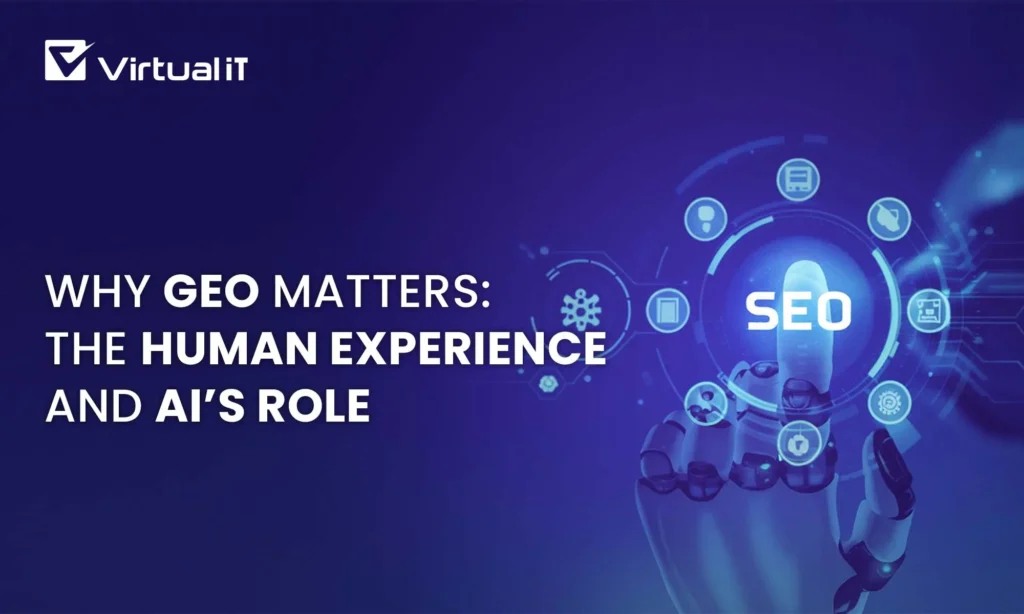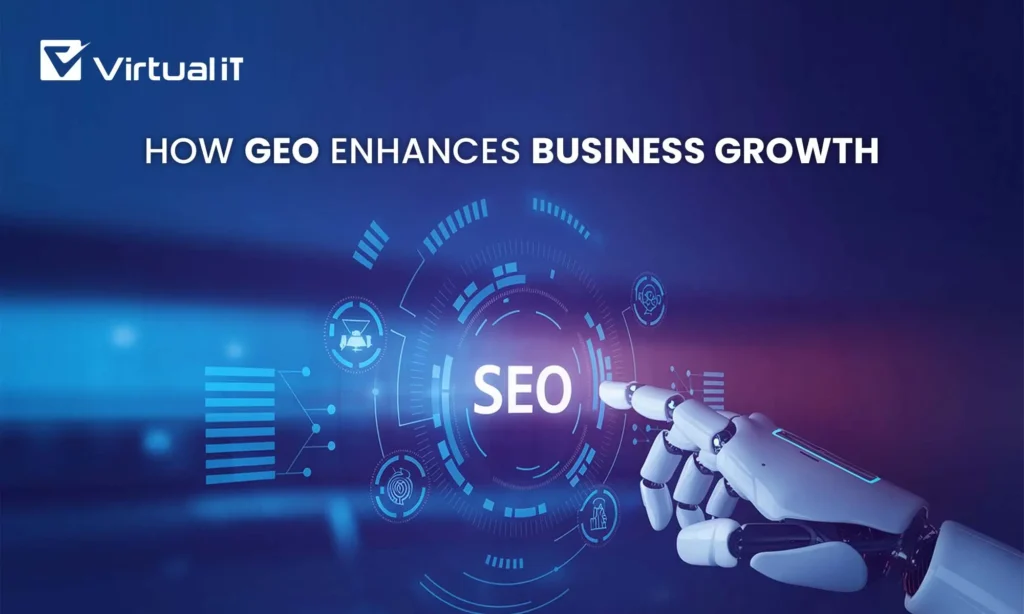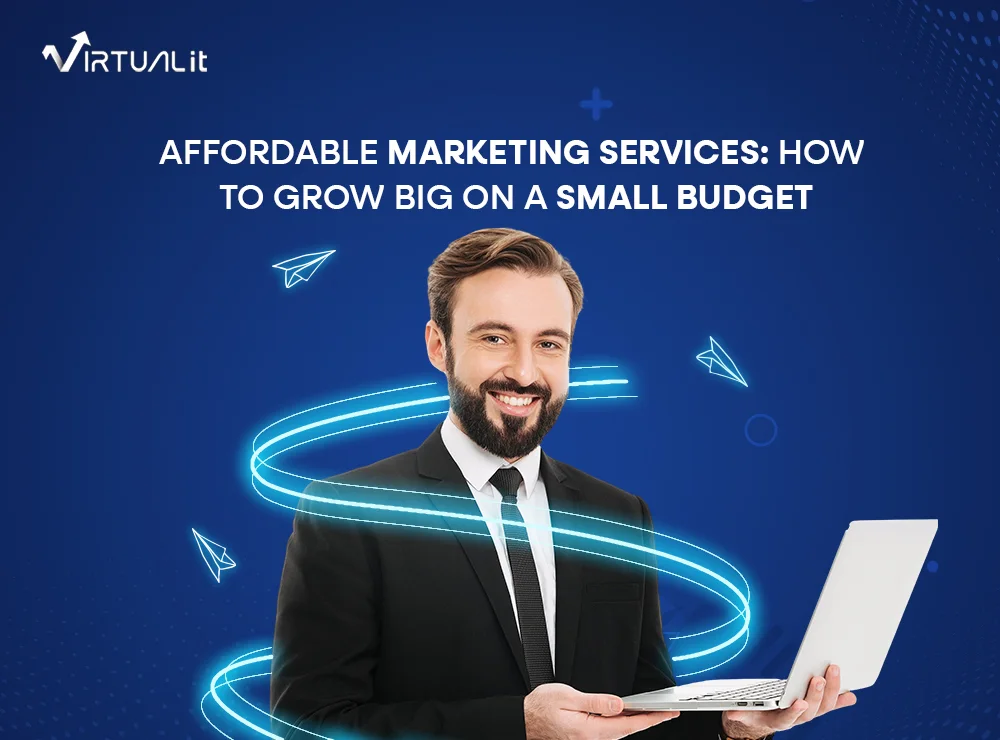The way businesses are found online is changing because of Generative Engine Optimization (GEO). GEO differs from traditional SEO in that it utilizes AI to identify user intent and emotional connection. This blog post discusses why GEO matters, SEO vs GEO, core principles, how experts are adapting it, and the practical steps to grow with it.
This is the era of AI. Everything is changing like a dream; every sector is now evolving with AI. In 2025, the rules have shifted. Search is no longer just about blue links on a page. People now trust AI engines to summarize, recommend, and make decisions about what matters. That’s where Generative Engine Optimization (GEO) comes in.
Instead of writing only for clicks, Generative Engine Optimization (GEO) is about writing for recognition. You create content that AI can pull, cite, and weave into its answers. Think less about chasing Google’s algorithm and more about becoming a source that large language models lean on.
This shift isn’t theory, it’s already happening. The Wall Street Journal has reported how AI summaries are eating into traditional search traffic. New York Magazine went even further: “SEO is dead. Say hello to GEO.” Also, the Economic Times recently pointed to companies like Asva AI and Siftly, which are building GEO-focused strategies for brands that don’t want to vanish from digital visibility.
So no, SEO isn’t dead. It’s evolving. If you want to be found in a world where AI is the new gatekeeper, Generative Engine Optimization (GEO) isn’t optional – it’s the future.
SEO vs GEO – Then vs Now
| Aspect | Traditional SEO (Then) | Generative Engine Optimization (GEO) Now, 2025 |
| Primary Goal | Rank in Google SERPs for clicks | Appear in AI-generated summaries, answers, and citations |
| Traffic Source | Organic clicks from SERPs | Zero-click answers from AI chatbots, AI Overviews, and conversational search |
| Content Focus | Keyword density, backlinks, and technical SEO | Conversational, structured, fact-based, semantically rich content |
| CTR Dependency | Critical for success | Almost irrelevant; AI may not show links but cites sources directly |
| Search Engines | Google and Bing dominate | AI engines: ChatGPT, Gemini, Perplexity, Claude, Google SGE |
| Format Optimization | Meta tags, titles, long-form blogs | FAQ, schema markup, structured data, prompt-optimized content |
| Ranking Factors | 200+ Google signals (links, speed, UX) | Trustworthiness, semantic clarity, factual accuracy, and content freshness |
| E-E-A-T Role | Important for SEO | Vital for GEO; AI prefers authoritative, expert sources |
| Zero-Click Searches | ~65% in 2020 (Sparktoro) | 80%+ in 2025 (WSJ reports for AI-driven answers) |
| Average Click Loss | Low impact earlier | Traffic dropped up to 30–50% for some brands due to AI answer prevalence |
| Tools Used | Ahrefs, SEMrush, Yoast, Google Search Console | Otterly.ai, Wix AI Visibility, GEO dashboards, AI content optimization tools |
| Future-Proofing | Continual keyword and link updates | AI citation optimization, monitoring AI outputs, and structured content |

Why GEO Matters: The Human Experience and AI’s Role
Search is no longer a doorway. For many, it’s the destination. People want answers, not to keep scrolling. Google’s AI Overviews show the change: summaries now take the place of links.
It’s not just a theory, either. According to The Wall Street Journal, brands like Mailchimp are getting fewer visits because bots are giving people answers right away. Surveys show the same thing: almost 60% of users now answer almost 40% of questions without ever clicking through. That’s the rise of search without clicking, and it’s here to stay.
At the same time, AI-first platforms like ChatGPT, Gemini, Perplexity, and Claude are changing the way we find things. They don’t use the old search funnel; instead, they give direct answers. If your content isn’t made for them, it could disappear.
The Core Principles of GEO: Getting Your Content in Front of the Right Eyes
1. Put clarity ahead of keyword density.
Adding buzzwords just to make a point makes it harder to read. Instead, talk to each other, make your point, and let the subject guide how you say things. People and processes are both rewarded equally.
2. Plan the learner’s journey ahead of time.
Think about the end before you start. Make your headings direct answers to search queries, like “What is the process for…” and “Here’s the step-by-step guide…” Systems like that are ordered because it match the way questions are asked.
3. Plan with machines in mind as well.
Use short paragraphs and bulleted lists. Set up the page as if it will go straight to another device. Add a schema, like an FAQ, to make it easy to read and copy.
4. Show authority that can be checked.
Use specific, up-to-date statistics, include trustworthy sources, and make sure that the dates of publication and updates are clear. The most important factor in getting referrals and repeat visits is trustworthiness.
5. Get the technical stuff ready.
Use fast hosting, clean HTML, and planned asset management. Crawlers use standard files like robots.txt and clear instructions in llm.txt to decide what content to show and what to ignore.
6. Check how your AI interacts with you.
Review the briefs and extract key statistics, such as the frequency of your content appearing in AI answers, public sentiment towards your brand, and changes in your visibility over time.
7. Use both traditional SEO and GEO strategies.
Real keyword practice gets you organic clicks, but Generative Engine Optimization GEO makes sure your insights show up in the answer box. Both strategies support each other and make sure that people can see them on all channels.
How SEO Experts Are Adapting to the GEO Era
Generative Engine Optimization (GEO) is a new way of doing things, not the end of marketing. You can still trust, be informed, and value the information you find. But now they work for AI-driven answers instead of just blue links and clicks. These are the changes that top Search Engine Optimization (SEO) experts are making in 2025:
Structuring Content for AI
Content isn’t just a big block of text anymore. Pros break it down:
- Question-shaped headings like “What is…” or “How do I…” “How to…”
- There are FAQs, short paragraphs, and bullet points.
AI really likes this. Clear, brief information is quoted. A lot of words? Often forgotten.
Schema and Machine-Friendly Markup
Markup is no longer an option. Things like FAQPage, HowTo, and Article schema are added by experts. A new standard for AI crawling called llms.txt is even being tried out by some. It’s like a map that computers can use to find your best stuff.
E-E-A-T But More than That
Experience, Expertise, authority, and trustworthiness. From now on, these signals tell AI who to cite. Marketers:
- Use reliable sources.
- Put in author bios and dates of publication.
- Include internal and external links that are full of context.
Keeping an eye on GEO Visibility
No longer are clicks the only thing that matters. Tools like Wix AI Visibility Overview show you how often AI cites your content and whether the citations are good or bad. SEMrush and Otterly.ai keep track of mentions in Gemini, Perplexity, and ChatGPT.
Testing Prompts Across AI
AI is directly asked by marketers:
- Does it claim my site is good?
- Does it say that my brand is trustworthy?
If it doesn’t, they change the facts, tone, and clarity until it does.
A hybrid GEO and SEO approach:
SEO isn’t dead; it’s just been combined with Generative Engine Optimization (GEO).
- Search results still depend on keywords from the past.
- AI is ready for conversational snippets that cover LLMs.
- Regular updates keep AI knowledge current.
Quick Fact: AppLabX found that more marketers now than before invest in Generative Engine Optimization (GEO). Many people are using Wix and Otterly.ai. The change is real, not just hype.
The main point? SEO isn’t being replaced by Generative Engine Optimization (GEO). It’s making it bigger. People see brands that play both games, and AI first cites those brands.

How GEO Enhances Business Growth
Generative Engine Optimization (GEO) does more than just keep you visible; it also helps your business grow. You’re not just trying to get clicks when AI puts your brand in answers. At the exact moment people decide what to do, you’re building trust. When people trust your business, it becomes a reliable authority. This helps people remember your brand and makes it easier for them to make purchases without relying only on search rankings.
GEO places products right in AI-powered shopping suggestions for online stores. People who use tools like ChatGPT and Perplexity for chatting often use service brands as answers. Research shows that early adopters get significantly more leads. AI rewards structured, trustworthy content with better engagement.
This also keeps your business from getting lost because it can answer so many questions with just one click. Instead, it makes you the person people trust the most.
Strategic Steps: Embrace GEO Emotionally and Practically
Picture your content as a steady voice. AI picks it up first, then passes it on to people the moment they’re searching. That’s where you want to be present, trusted, human.
Audit what you’ve got. Cut down long blocks. Reshape them into short, clear pieces. Add schema markup if it helps machines read you better. Keep it easy for humans, too.
- Answer first. Don’t bury the point. Open with a quick response, then explain the details after. That simple rhythm keeps both AI and people engaged.
- Stay current. Generative Engine Optimization (GEO) isn’t set-and-forget. AI shifts, algorithms change, and your content needs to move with it. Update often.
- Watch the signals. Even basic analytics tell you something. Tools like Wix or Otterly.ai provide a clearer view of how often your brand appears in AI answers.
- Test it yourself. Ask ChatGPT. Ask Gemini. Ask Perplexity. See if you’re there. If not, refine until you are.
- Don’t ditch SEO. Generative Engine Optimization (GEO) doesn’t replace it. SEO still drives search traffic. GEO makes sure you’re part of AI answers. Together, they cover both fronts.
Emerging Tools & Innovation
Wix now has an AI Visibility Overview feature. It shows how often people talk about your site, how they feel about it, and how you stack up against competitors.
When you use Otterly.ai with SEMrush, you can keep an eye on when your brand is mentioned inside AI outputs, which is something that regular SEO tools can’t do.
Then there’s AI SEO (AIO) and Answer Engine Optimization (AEO). They are both very related to GEO. Their goal? Feed chatbots content that is clear, trustworthy, and full to change how they respond.
How Search Is Shifting from Google to AI in 2025
According to recent data, Google’s global search share fell below 90% for the first time in 2025, ranging between 89.6% and 89.7%. This marked a significant shift from the years when it was almost completely dominant.
Also, AI-generated Overviews are now turning up in over 12–13% of all Google searches, up from just 6.5% in January. This is a 72% increase from March to April. At the same time, an increasing number of people are using AI tools. For example, ChatGPT handles over 1.1 billion queries every day.
What is Generative Engine Optimization (GEO)?
GEO stands for “Generative Engine Optimization.” It is the process of making material better for AI search. Check out tools like ChatGPT, Gemini, and Perplexity. Not just getting a high Google rank is essential; the information should be correct, helpful, and worth using when AI replies.
Should I get GEO instead of SEO?
You still need both, though. SEO brings in leads for free. When people talk about AI tools, GEO will definitely bring up your name. This time, one is about search engines and the other is about home helpers. They work together.
How do I make my content AI-ready?
Do not mess around. Keep it structured. Use questions and answers, bullet points, and headers. Where it makes sense, like on an FAQ page or a how-to, add schema markup. It’s important to be clear, correct, and share sources when you can. Writing should be simple and clear, like how you’d explain something to a coworker.
Does Generative Engine Optimization (GEO) help e-commerce?
Yes, quite. Most of the time, AI tools suggest things right away. If your content is improved, your item is more likely to show up in those suggestions, even if the customer doesn’t visit your website.
How can I check how well my GEO is working?
Try it out for yourself. If you ask ChatGPT, Gemini, or Perplexity about your field, your brand name might come up. You can also use tools like Otterly.ai or the AI presence features on Wix. Monitor discussions closely; this helps you determine if AI is actually using your material.
What’s the future of Generative Engine Optimization (GEO)?
Generative Engine Optimization GEO is going to get bigger. As people rely less on Google and more on AI helpers, brands that adapt quickly will reap significant benefits. It’s no longer just about clicks; it’s about showing where decisions are being made.
Final Words: A Hopeful Future of Human-Centric Visibility
SEO isn’t disappearing; it’s merely acquiring a brand-new voice through Generative Engine Optimization (GEO). When AI takes over as your guide, your content becomes more than just keywords. People hear it first as a story. And stories matter. They link with genuine human sensations in ways algorithms can’t fake.
If you wish to move further, we can sketch GEO-friendly layouts, reveal how schema works in practice, and even refine triggers and tools with you. You show up clearly, confidently, right at the minute somebody asks. Your brand name, your voice, your response.




